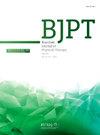Factors related to motor outcomes in adolescents and adults with cerebral palsy: A systematic review
IF 3.2
3区 医学
Q1 ORTHOPEDICS
引用次数: 0
Abstract
Background
Although the brain injury caused by cerebral palsy (CP) is not progressive, there is often a worsening of physical conditions during the transition to adolescence and adulthood. The aim of this systematic review was to summarize factors related to decline in motor function in adolescents and adults with CP.
Methods
This review was registered in PROSPERO (CRD42022311783). Studies met the following criteria: participants diagnosed with CP, ages 10 to 59 years; scientific studies with any methodological design and emphasis on motor function, reporting quantitative analysis of the effect of age on motor function or factors relevant that declined or improved motor capacity; published in English; any publication year, in electronic databases: Pubmed/Medline, Scopus, Cinahl. Data selection and extraction used the Covidence software. Factors related to motor outcomes that were statistically significant in at least one study and present in more than one study were reported. The outcomes were grouped within major categories (gross motor function, neuromusculoskeletal functions, and gait) for summary.
Results
23 studies met the inclusion criteria. Relevant factors for changes in gross motor function (n = 16 studies) were: pain, neuromusculoskeletal aspects, altered gait parameters, Gross Motor Function Classification System (GMFCS) level, age, and history of surgery; for gait (n = 11): mobility performance, altered gait parameters, age, GMFCS level, pain and neuromusculoskeletal aspects; and for neuromusculoskeletal functions (n = 4): altered gait parameters, neuromusculoskeletal aspects, age, pain, and GMFCS level.
Conclusion
Age, GMFCS level, and presence of pain stood out as significant for motor decline across categories. Monitoring these factors is relevant for planning interventions and transition programs.
与青少年和成人脑瘫患者运动预后相关的因素:一项系统综述
虽然脑瘫(CP)引起的脑损伤不是进行性的,但在向青春期和成年期过渡的过程中,身体状况往往会恶化。本系统综述的目的是总结青少年和成人cp患者运动功能下降的相关因素。方法本综述已在PROSPERO杂志注册(CRD42022311783)。研究符合以下标准:被诊断为CP的参与者,年龄在10至59岁之间;以任何方法设计并强调运动功能的科学研究,报告年龄对运动功能的影响或运动能力下降或提高的相关因素的定量分析;以英文出版;任何出版年份,电子数据库:Pubmed/Medline, Scopus, china。使用covid软件进行数据选择和提取。与运动结果相关的因素在至少一项研究和不止一项研究中均有统计学意义。结果按主要类别(大运动功能、神经肌肉骨骼功能和步态)分组总结。结果23项研究符合纳入标准。大运动功能改变的相关因素(n = 16项研究)有:疼痛、神经肌肉骨骼方面、步态参数改变、大运动功能分类系统(GMFCS)水平、年龄和手术史;步态(n = 11):活动能力、改变的步态参数、年龄、GMFCS水平、疼痛和神经肌肉骨骼方面;神经肌肉骨骼功能(n = 4):步态参数、神经肌肉骨骼方面、年龄、疼痛和GMFCS水平的改变。结论年龄、GMFCS水平和疼痛的存在对运动能力下降有显著影响。监测这些因素与规划干预措施和过渡方案有关。
本文章由计算机程序翻译,如有差异,请以英文原文为准。
求助全文
约1分钟内获得全文
求助全文
来源期刊
CiteScore
6.10
自引率
8.80%
发文量
53
审稿时长
74 days
期刊介绍:
The Brazilian Journal of Physical Therapy (BJPT) is the official publication of the Brazilian Society of Physical Therapy Research and Graduate Studies (ABRAPG-Ft). It publishes original research articles on topics related to the areas of physical therapy and rehabilitation sciences, including clinical, basic or applied studies on the assessment, prevention, and treatment of movement disorders.

 求助内容:
求助内容: 应助结果提醒方式:
应助结果提醒方式:


